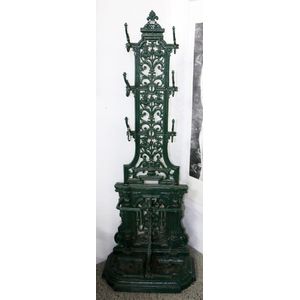Greek Bronze Hydria Urn, Hellenistic Period
You must be a subscriber, and be logged in to view price and dealer details.
Subscribe Now to view actual auction price for this item
When you subscribe, you have the option of setting the currency in which to display prices to $Au, $US, $NZ or Stg.
- Circa - A Latin term meaning 'about', often used in the antique trade to give an approximate date for the piece, usually considered to be five years on either side of the circa year. Thus, circa 1900 means the piece was made about 1900, probably between 1895 and 1905. The expression is sometimes abbreviated to c.1900.
- Bronze - An alloy of copper and tin, traditionally in the proportions of about 9 parts of copper to 1 part of tin.
The discovery of bronze in Western Asia in the 4th century enabled people to create metal objects which were superior to those previoulsy possible because of its strength and hardness, and it has been used throughout the world for weapons, coins, tools, statuary and other decorative items.
It is very fluid in a molten state, and its hardness, strength when set, and non-corrosive properties makes it most suitable for casting sculpture. - Hellenistic - The Hellenistic period is a period in ancient Greek history
that began after the death of Alexander the Great in 323 BCE and lasted until
the Roman conquest of Greece in 146 BCE. It is named after the Greek word
"Hellenistic," which means "to imitate Greeks."
During the Hellenistic period, the Greek world expanded
beyond the boundaries of Greece and encompassed the territories conquered by
Alexander the Great, including Egypt, Persia, and parts of India. The period
was marked by a fusion of Greek culture with the cultures of these conquered
territories, resulting in a diverse and cosmopolitan society.
The art and architecture of the Hellenistic period were
marked by a new sense of realism and individuality. Artists and architects
experimented with new techniques and styles, and the incorporation of new
materials such as bronze and glass. A number of the best-known works of Greek sculpture belong to this period, including Laocoon and his Sons, Venus de Milo, and the Winged Victory of Samothrace. - Patination / Patina - In broad terms, patination refers to the exterior surface appearance of the timber, the effect of fading caused by exposure to sunlight and air over the course of a century or more, changing the piece to a soft, mellow colour.
As patina is very difficult to replicate, it is one of the most important guides to determining the age of furniture.
Patina is also the term applied to the bloom or film found on old bronzes due to oxidisation.
This item has been included into following indexes:
Visually similar items

19th century green painted wrought iron outdoor coat and umbrella stand, in the manner of Coalbrookdale. 185 cm x70 cm

Antique Regency inlaid mahogany bow front chest of five drawers, 106 cm wide

C1950s travel poster 'Discover Australia'. Art work by James Northfield. Linen backed. 101 cm x 63.5 cm. Condition B

A Chinese inside-painted glass snuff bottle, Chen Runpu (b. 1946), dated 1979 'butterfly and cat' in the style of Cao Kejia, 8 cm. Provenance: Purchased at. Y.F. Yang & Company in the late 1980s and early 1990s in Hong Kong Cao Kejia (1906 - 1979), a paint
